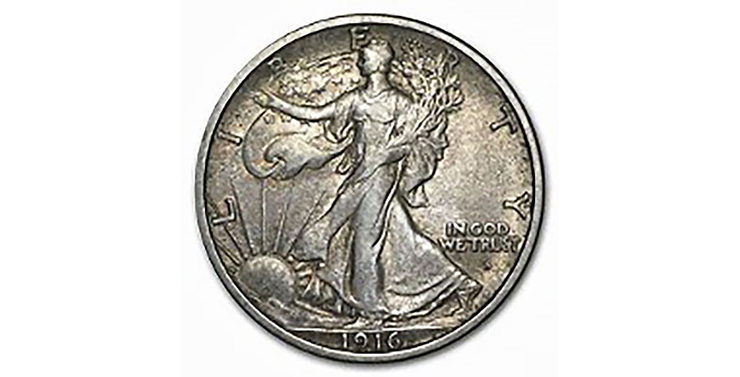By Douglas Keefe
This is the final article about collecting “key” coins, that is, the coins that have the lowest mintage and the highest value in a series. Previous articles covered cents through quarters. Now we’ll look at half-dollars minted from 1916 through the end of the 1900s.
Working backwards, Kennedy half-dollars were first struck in 1964 to commemorate our assassinated president. 1964 was the last year our dimes, quarters and half-dollars were made of 90% silver. After 1964 the dimes and quarters were minted with the familiar sandwich-clad copper covered with nickel. However, for what can only be considered a government decision, it was decided to mint the half-dollars with 40% silver, which continued until 1971 when the half also was struck in copper and nickel. There are no real “keys” in this series as most years had high mintage figures in spite of the dwindling popularity of having half-dollars in pocket change. Because of the lack of popularity, the half-dollar is now struck only for collectors. None are released for circulation.
The half-dollar that preceded the Kennedy half was the Franklin half-dollar which obviously featured a portrait of Ben Franklin. Franklin was only the fifth real person to have his likeness on a regular issue United States coin, and the first who was not a president. Those before him were Washington, Jefferson, Lincoln and Roosevelt. Once again, due to high mintage figures there are no key coins in this series. The only one that even comes close is the 1955 dated half which has the lowest mintage. But because so many were hoarded, their price is only slightly higher than the other dates, not making it a good candidate for appreciation in value.
The series of half-dollars that contain coins that can be considered keys is the Walking Liberty half-dollars struck from 1916 until 1947. Unlike the dimes and quarters, only the Walking Liberty design was minted in 1916 and at all 3 mints, Philadelphia, Denver and San Francisco, with the mintmarks “D” and “S” for the latter 2 mints appearing on the front of the coin. Midway through 1917, because it was felt the mintmark detracted from the appearance of the coin, the mint marks were moved to the reverse.

There are several coins in the Walking Liberty half-dollar series that are considered key coins, starting with half dollars dated 1921-D. The 1921 from the Denver mint is the main key in fine condition, costing around $500, followed by the 1921 from the Philadelphia mint at around $280 and the 1921-S at $205. The interesting thing about the half-dollars from 1921 is the relative values change in uncirculated condition, with the 1921-S becoming much more expensive than the other 2 by an order of magnitude of 2 ½ to 4 times more expensive. An average uncirculated 1921-S is valued at around $20,000. Although the San Francisco mint struck more coins than the other 2 mints, evidently fewer were saved in uncirculated condition by collectors.
All of the first year 1916 halves are keys in fine or better condition and the low mintage 1938-D is considered a semi-key and is fairly inexpensive in higher than fine condition.
This concludes my articles about key coins. The coins I have written about have always been the hardest to find in decent condition and always have commanded the highest prices, therefore I feel they make good investments.















